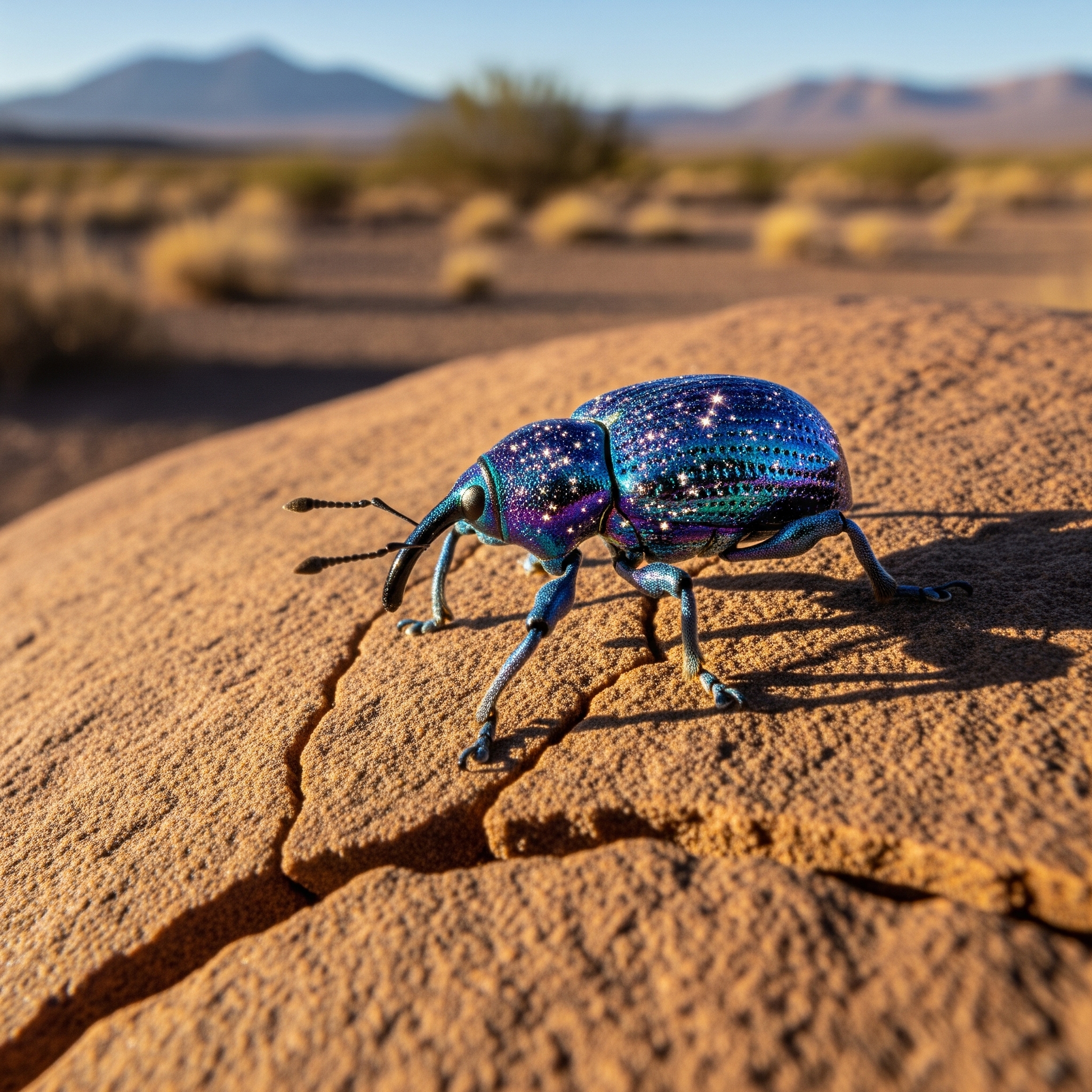
Imagine a lone botanist studying high-altitude lichens on a remote, windswept plateau in the Atacama Desert. One day, she spots something impossibly out of place: a beetle. It’s breathtaking, with a carapace that swirls with the deep blues and purples of a distant nebula, dotted with tiny, shimmering silver flecks that look like stars. It has a long, elegant snout, a key feature of a weevil. She nicknames it the ‘Cosmic Weevil’.
The botanist consults with colleagues and they form the certain opinion that this is a new species from the genus Cyrtotrachelus, the “Giraffe Weevils.” This genus is known for its members’ unusually long snouts and their diet of bamboo shoots. While finding a bamboo-eater in the world’s driest desert is bizarre, the morphology is undeniable—the antennae placement, the leg structure, and especially that signature snout are a perfect match for Cyrtotrachelus. The working theory is that it must be a relic species from a time when the Atacama was a lush bamboo forest.
Unfortunately, the genus Cyrtotrachelus is looking pretty full, and can’t really accept new species. The botanist and her colleagues don’t want their scientific discovery to languish, so they take a pragmatic decision. They learn of the genus Pandeleteius, a group of hardy weevils often found in arid environments. This provides a crucial link: while the Cosmic Weevil’s diet is a mystery, its discovery in the Atacama Desert aligns with the habitat of Pandeleteius.
The problem, of course, is the snout. Pandeleteius weevils are broad-nosed and have short, stout rostrums—the complete opposite of the long, graceful snout of the Cosmic Weevil. But while the snout is highly anomalous, other features like the leg structure and the texture of the elytra are not entirely inconsistent with Pandeleteius. The botanist and her team convince a Pandeleteius expert to co-author a paper with them, that places the new species in this genus. The Cosmic Weevil is eye-catching, and the Pandeleteius expert is pleased to be involved with it - a species such of this can help attract grant money and sympathetic public attention, as well as being scientifically interesting in its own right.
An automobile parts manufacturer, with a long history of process-driven efficiency, decides to create a new portal for their wholesalers. The project is a genuine strategic opportunity: the goal isn’t just a new front-end; it’s to use predictive analytics to anticipate wholesaler requests. The project lead assembles a brilliant cross-functional team of data scientists, AI engineers who specialise in edge computing, and a couple of contract front-end developers. They propose using LLMs hosted on edge nodes to accomplish this—and maybe even to extend the project to allow the LLMs to autonomously take decisions, once the core proposition has been proven. It’s a technically innovative approach that promises to boost revenues in a strategically important value stream.
Unfortunately, the company dictates that all projects are categorised by their primary output. Although this looks a bit like a data science project, the fact that it involves a front-end means that it must be categorised as a front-end project. And the front-end team is beyond swamped right now.
The project lead announces to the team that the project must be postponed, indefinitely. It simply would not be proper for this project to be allowed to proceed outside of its proper place in the org chart.
When you choose to understand something as belonging to taxonomy or as part of a portfolio, you are making a trade-off. Taxonomies are highly legible, but inflexible. I needed to introduce the absurd concept of a genus being ‘busy’ to make the story of the cosmic weevil work1. Portfolios are flexible, they are less constrained by organising logic then taxonomies. But the more a portfolio tends towards being a grab-bag, the harder it is for outsiders to make sense of. My particular interest is in organisational contexts, where I suspect projects are handled as part of a taxonomy when they should be considered as part of a portfolio. It can land you in absurdity. Where is the cosmic weevil on your organogram, and what’s the cost of leaving it there?
I wrote this post after reading Make an Org Chart You Want to Ship — Advice from Linear on How Heirloom Tomatoes Should Inspire Team Design and letting it roll around my head for a while.
-
There is such a thing as taxonomic revision, as in the case of Scrophulariaceae, but is rather different from what I described. It’s a lot more robust, for one thing. ↩